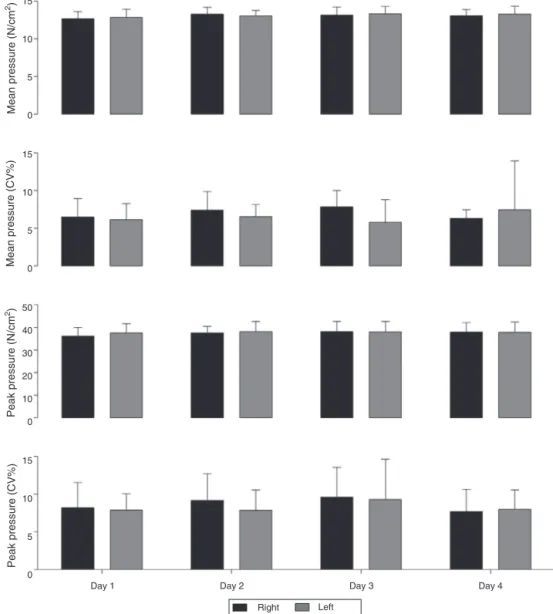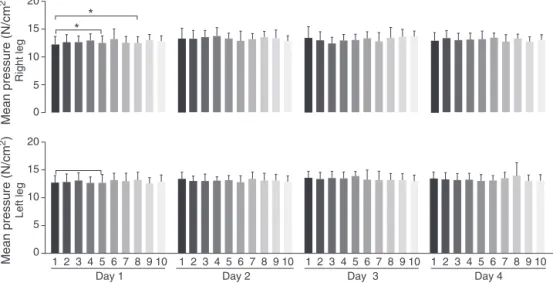w w w . r e u m a t o l o g i a . c o m . b r
REVISTA
BRASILEIRA
DE
REUMATOLOGIA
Original
article
Variability
and
repeatability
analysis
of
plantar
pressure
during
gait
in
older
people
Pedro
S.
Franco
a,b,
Caio
Borella
P.
da
Silva
a,
Emmanuel
S.
da
Rocha
a,b,
Felipe
P.
Carpes
a,b,∗aAppliedNeuromechanicsResearchGroup,NeuromechanicsLaboratory,UniversidadeFederaldoPampa,Uruguaiana,RS,Brazil bGraduationPrograminPhysicalEducation,UniversidadeFederaldeSantaMaria,SantaMaria,RS,Brazil
a
r
t
i
c
l
e
i
n
f
o
Articlehistory:
Received12August2014 Accepted17March2015 Availableonline9August2015
Keywords:
Gait Kinetics Aging Biomechanics Foot
a
b
s
t
r
a
c
t
Introduction:Repeatabilityandvariabilityoftheplantarpressureduringwalkingare impor-tant componentsinthe clinicalassessment oftheelderly. However,there isa lack of informationontheuniformityofplantarpressurepatternsintheelderly.
Objective:Toanalyzetherepeatabilityandvariabilityinplantarpressureconsideringmean, peakandasymmetriesduringagedgait.
Methods:Plantarpressurewasmonitoredinfourdifferentdaysfortenelderlysubjects(5 female),withmean±standard-deviationageof73±6years,walkingbarefootatpreferred speed.Datawerecomparedbetweenstepsforeachdayandbetweendifferentdays.
Results:Meanandpeakplantarpressurevaluesweresimilarbetweenthedifferentdaysof evaluation.Asymmetryindexesweresimilarbetweenthedifferentdaysevaluated.
Conclusion: Plantarpressure presenteda consistentpatternintheelderly.However, the asymmetryindexesobservedsuggestthattheelderlyareexposedtorepetitiveasymmetric loadingduringlocomotion.Suchresultrequiresfurtherinvestigation,especiallyconcerning theroleoftheseasymmetriesfordevelopmentofarticularinjuries.
©2015ElsevierEditoraLtda.Allrightsreserved.
Análise
da
variabilidade
e
repetibilidade
da
pressão
plantar
durante
a
marcha
de
idosos
Palavras-chave:
Marcha Cinética Envelhecimento Biomecânica Pé
r
e
s
u
m
o
Introduc¸ão: Arepetibilidadeeavariabilidadedapressãoplantaremavaliac¸õesdamarcha sãocomponentesimportantesnaavaliac¸ãoclínicadoidoso.Contudo,poucoéconhecido sobreaconsistênciadospadrõesdepressãoplantaremidosos.
Objetivo:Analisaravariabilidadeerepetibilidadedapressãoplantardurantedamarchade idosos,considerandovaloresmédios,picoseassimetrias.
∗ Correspondingauthor.
E-mail:carpes@unipampa.edu.br(F.P.Carpes).
http://dx.doi.org/10.1016/j.rbre.2015.07.010
Métodos:Apressãoplantarfoiavaliadaemquatrodiferentesdiasemdezidosos(5mulheres), comidademédia±desvio-padrãode73±6anos,duranteoandardescalc¸oemvelocidade preferida.Osdadosdepressãoplantarforamcomparadosentreaspisadasemcadadia,e entreosdiferentesdiasdeavaliac¸ão.
Resultados: Dadosdepressãomédia epicoforamsimilaresentreos diferentesdiasde avaliac¸ão.Osíndicesde assimetriaobservadosforamsimilaresentreosdiferentesdias avaliados.
Conclusão: Apressãoplantar(médiaepico)apresentouumpadrãoconsistentenosidosos. Contudo,osíndicesdeassimetriaobservadossugeremqueidososestejam sistematica-menteexpostosacargasassimétricasdurantealocomoc¸ão.Estaobservac¸ãorequerfuturas investigac¸ões, especialmente em relac¸ãoao impacto destas assimetrias na origem de doenc¸asarticulares.
©2015ElsevierEditoraLtda.Todososdireitosreservados.
Introduction
Gaitisvitalforolderpeopleinorder tomaintain indepen-dence,asitallowscarryingoutdailyactivitiesandcontributes to the functioning of various body systems. Since biped walking is a common ability to humans, it serves both asa means oflocomotionas anexercise modality.During the gait, every contact of the feet to the ground gener-ates an impact due to the action of the ground reaction forces.1,2
Based on force measurements and area of foot con-tact withthe surface,it ispossibleto quantifythe plantar pressure during walking. Thus, we can access important informationforthe investigationofthe stressgeneratedin thedifferentregionsofthe plantarsurface.3 Thepublished
data suggests that older people experience higher plantar pressure on the regions of the 2nd, 3rd and 5th metatar-sophalangealjointsandhalluxwhenwalking.4Thisincrease
ofplantarloadonsofttissues,whichhavestiffeneddueto theaging process,oftenprogresses tometatarsalgiainthe elderly.5
Additionally,excessiveexposuretoloadsonthesofttissues ofthefeetmayleadtoproblemscommonlyknownaspressure ulcers.6Theseinjuriescanarisefromrepetitivemicrotrauma,
causingadecreaseintheelasticfibroustissuewatercontent andagraduallossofcollageninthefatpadoftheheel, con-tributing tothedecrease in elasticityand the abilityoffat padtoabsorbimpact.7,8Thechangesinmechanical
proper-tiesofheelfatcushionalsoleadtoimpact-inducedinjuries, andtoheelpain.9Theseconditionshavebeenassumedtobe
similarbetweenlowerlimbs.However,evidencesuggeststhat functionallateralizationisadynamiccomponentofhuman motordevelopment,andcaninfluencedifferencesbetween thelowerlimbsduringgait.10
Inthe contextofhumanlocomotion, thesubject ofour study,asymmetriescan beseenasdeviationson the simi-larityofperformanceamongrightandlefthemibody.These deviationsareconsideredsignificant,basedonstatisticaltests orfromtheapplicationofsymmetryindexes.11Many
stud-ieshavediscussedtheeffectsofasymmetriesinlocomotion parameters,suggestingthatasymmetrymayinfluence perfor-mancecharacteristicsandalsotheriskofinjurytothelower limbs.11,12
Chavet et al.13 assessed asymmetries in a scenario of
impactandshocktransmissioninlowerlimbsandsuggested that the repetition ofasymmetries can bemore damaging thanitsownmagnitude.Thatis,evenlowratesof asymme-try,ifexperiencedinarepetitivemanner,canbeariskfactor forinjuries.13Inthissense,theasymmetryindex
quantifica-tioncanprovideimportantparametersfortheevaluationof asymmetricloadsinlocomotion.Consideringtheabove obser-vationsontheabilityofimpactabsorptionduringgaitinthe elderly,14repeatabilityofasymmetriesinthegaitinthis
pop-ulationcanbeariskfactorfortheonsetoffootinjuries.The popularizationoftheuseofbaropodometrysystemsboosts the discussion ofthe clinical applications ofplantar pres-sure measurement intheevaluationofhumanmovement, especially in relation to variability and consistency of the measures.15Previousstudieshavesuggestedthataminimum
ofthreemeasurementsineach testwould benecessaryto obtainagoodlevelofconsistencyinmeasures.16,17
However,littleisknownabouttherepeatabilityofplantar pressureparametersintheelderly.Inaddition,mostclinical evaluationsarecarriedout inonlyoneday,notconsidering possible variationsthat may occur whenmoreevaluations are performed.From thepointofview oftheasymmetries, the repetitiveloadcanresultinagreaterriskthanits own magnitude,andtherearefewstudiesthatinvestigatethese issuesinthegaitoftheelderly.Thus,thisstudyaimedto ana-lyzerepeatedmeasuresofplantarpressureduringthegaitof elderly people,inordertodiscusstheconsistencyofmean andpeakpressuremeasurements,aswellastheasymmetry indexesondifferentdays.
Material
and
methods
Participants
week.Allseniorsdeemedtobeindependentwereinvitedto participateintheexperimentandthosewhohavecompleted thefourevaluationsinamaximumperiodofsevendayswere includedinthisstudy.Eventhosewhodidnotcompletethe protocolinthedefinedperiodreceiveddetailedresultsoftheir assessments,whichwereexplainedbyaphysicaltherapist. DatawerealsoprovidedfortheCommunityCenter,inorder tobefiledwithdocumentsandotherclinicalexaminationsof theseelderlypeople.Thenumberofsubjectsincludedinour studywassimilartothatinstudieswithasimilarscope18,19
and,asdescribedbelow,itwasnotedthattheparticipantshad afairlyhomogeneousperformance.
Tobeincluded,participantshadtobeaged60yearsorolder andbeabletowalkwithout assistivedevices.Theyshould attendattheassessmentsiteinpreviouslyscheduleddays andtimes.Inthecaseofcontactlensesuserforvisual correc-tion,thesedevicesshouldbeusedintheevaluationdays.The elderlyshouldnothaveskinlesionsontheirfeetnor deformi-tiesthatcouldinfluenceplantarpressure.Exclusioncriteria were:injurytoanyofthelowerlimbsinthelastyear,lower extremitiesclaudication,musculoskeletaland/or neuromus-culardiseasesaffectingindependentwalking.Beforestarting participationinthestudy,allseniorssignedaninformed con-sentformapprovedbytheresearchethicscommitteeofthe localuniversity(Protocol062011).
Studydesign
Our research has a cross-sectional observational design, wheretheelderlywereassessedwhenwalking barefoot,as they walked in their preferred speed along a path of 9m inastraightline.Theevaluationwasperformedbarefootin ordertominimizetheinfluenceoffootwearonmeasuresof interest inthis study.The gait protocol was repeated in 4 non-consecutivedays,inanintervalofnomorethanseven daysbetweenassessments.Foreachevaluationday,the plan-tarpressure measurements were recorded for10 footsteps witheachfoot.Theplantarpressureinformationwasrecorded usinganinstrumentedmat,positionedinthemiddleofthe path. Wehaveattempted toconduct the evaluationofthe gaitalwaysatthesamehourandtimeoftheday,preferably between09:00and12:00h.Datawerecomparedbetween foot-stepsoneachday,andbetweendifferentdaysofassessment. Theasymmetryindexwasalsocalculatedforallfootstepsand daysofevaluation.
Plantarpressureassessment
Acomputerizedbaropodometergaitmat(Matscan,Tekscan Inc.,USA)was usedtorecord plantarpressureduringeach footstep.Datawererecordedata400Hzsamplingrate.Plantar pressuremeasurementswereperformedtodeterminemean andpeakpressures,consideringtheentireareaoffootcontact withthegroundin10footstepsrecordedforeachfootineach day.Fromthisinformation,asymmetryindexesbetweenthe legswerealsoquantifiedformeanandpeakpressures, deter-minedonthebasisofthetotalareaoffootcontactwiththe ground.
Fordataacquisition,theinstrumentedmatwaspositioned inthe middleofthe9-m path.Datawere measuredwitha
resolutionof1.4sensorspersquarecentimeter,totaling2288 sensors.Footstepswithrightandleftfootwerecollected ran-domly,andthesubjectswerenotaskedtostepwithacertain footonthemat.Thesubjectdidnotknowwhenanattempt wasvalidornot;he/shejustwasinformedabouttheendof the experiment, when10 footsteps foreach foot had been recorded.Fromtheinformationonplantarpressure,we calcu-latedthemeanandpeakpressuresfortheentireareaofeach foot,ineachfootstep.Attemptswereconsideredvalidwhen thewholefoottouchedthebaropodometerpositionedonthe ground.18,19
Meanspeedevaluation
To measure the mean speed of each participant and thus tocharacterize the groupofparticipants,the walking time was timedbythe examiner usinga digital timer(SW2018, CRONOBIO,Brazil).Themeanspeedwascalculatedfromthe informationondistancecoveredandontimeforeach9-m dis-tance;subsequently,themeansforeachdaywerecalculated.
Statisticalanalysis
Dataofmeangaitspeedweregroupedinmeanandstandard deviation,forcomparisonbetweenthedays.Forplantar pres-sure data(mean and peakpressures), the informationwas arrangedinmeanand standarddeviationformat, consider-ingthevaluesof10footstepseachday,foreachleg.Datawere comparedbetweenfootstepsateachday,andbetween differ-entdaysofassessment.Thecoefficientofvariation(CV)was calculatedusingstandarddeviation/meanratio.
Toverifythenormalityofdatadistribution,theShapiro– Wilktestwasused.Theone-wayANOVAwithposthocTukey test was used to compare variables among the four days, aswell astocomparethe footstepseachdayforright and left legs. Toexpress the magnitudeof the asymmetries in each day, the asymmetry index (AI) was calculated, using Eq. (1).10 The level of significance was set at 0.05 for all
analyzes. Statistical analyses were performed using SPSS version17.0.
AI%=[(right−left)/right]∗100 (1)
Results
Theclinicalcharacteristicsoftheparticipantsarepresented
inTable1.
Whenplantarpressuredataforeachfootwerecompared betweendifferentdays,weobservedaconsistentpatternin meanpressure,withnodifferencebetweendaysforboththe rightleg(F(3)=0.728;p=0.542)andleftleg(F(3)=0.495;p=0.688). Similarresultswereobservedforpeakpressureforboththe rightleg(F(3)=0.526;p=0.667)andleftleg(F(3)=0.033;p=0.992) (Fig.1).
When the plantar pressure variability was compared betweendifferent days,wealsoobserved aconsistent pat-ternofvariationinmeanpressure overthefourdays,with no significant differencesforboththe right leg(F(3)=1.245;
Table1–Clinicalcharacteristicsoftheparticipants.Data
presentedasmean±standarddeviation.BMI,body
massindex,calculatedbydividingthebodyweightby
theheightsquared.
Characteristics Mean±standard
deviation
Age(years) 73.20±6.09
Bodyweight(kg) 66.35±13.03
Height(m) 1.62±0.07
Meanspeed(m/s) 0.88±0.14
BMI(kg/m2) 25.40±4.58
alsoobservedforthevariabilityofthepeakpressureforboth the right leg (F(3)=0.600; p=0.619), and left leg (F(3)=0.415; p=0.743)(Fig.1).
Themean±standarddeviationoftheasymmetryindexfor meanplantarpressure ondifferentdayswas 4.79%±0.99% andforpeakpressurewas6.73%±1.36%.Bothindexeswere similarbetweenthefourevaluationdays(F(3)=0.986,p=0.410
andF(3)=0.125;p=0.944formeanandpeakpressure, respec-tively).
By comparing the asymmetry index of mean and peak pressures,nosignificantdifferenceswereobservedonthefirst (t(9)=−1.740; p=0.116), second (t(9)=−1.161; p=0.275), third (t(9)=−1.308;p=0.223),orfourthevaluationday(t(9)=−0.072;
p=0.944)(Fig.2).
Whenthemeanpressurefortherightandleftleg(Fig.3) was comparedbetween10footstepsanalyzedoneach day, the results showed that on day 1, there was an effect of footsteps on mean pressure (F(9)=11,092; p=<0.001) where the post hoc test indicated difference between the 1st and 5th footstep(p<0.05)andbetweenthe1st and8thfootstep (p<0.05).
Inotherfootstepsandotherdays,wedidnotobserveany differencebetweenthefootstepsoftherightleg(F(9)=0.405,
p=0.930; F(9)=0.795, p=0.622; F(9)=0.477; p=0.886; for days 1,2,3and4,respectively)and leftleg(F(9)=0.302,p=0.972;
F(9)=0.312,p=0.969;F(9)=0.446;p=0.906;F(9)=0.288,p=0.977; forthedays1,2,3and4,respectively).
15
10
5
0
15
10
5
0
50
40
30
10 20
0
Mean pressure (N/cm
2)
Peak pressure (N/cm
2)
Mean pressure (CV%)
15
10
5
0
Day 4 Day 3
Day 2 Day 1
Peak pressure (CV%)
Right Left
Fig.1–Comparisonamongdaysformeanandpeakplantarpressures.Mean(columns)andstandarddeviation(vertical lines)formeanpressure(N/cm2),meanpressurevariability(CV%),peakpressure(N/cm2)andpeakpressurevariability
15
10
5
0
Day 1 Day 2 Day 3 Day 4
Asymmetries (%)
Mean Peak
Fig.2–Comparisonofasymmetryindexesformeanandpeakplantarpressureamongdays.Mean(columns)andstandard deviation(verticallines)fortheasymmetryindex(%)inthefour-dayevaluationformeanpressure(blackcolumns)andpeak pressure(graycolumns).
Whenthepeakpressurefortherightandleftlegs(Fig.4) wascomparedamongthe10analyzedfootstepsoneachday, therewasnodifferencebetweenfootstepswiththerightleg (F(9)=0.359,p=0.951;F(9)=0.706,p=0.702;F(9)=0.419,p=0.922;
F(9)=0.454,p=0.901;forthedays1,2,3and 4,respectively) orwiththeleftleg(F(9)=0.359,p=0.951;F(9)=0.196,p=0.994;
F(9)=0.380,p=0.942;F(9)=0.189,p=0.995;forthedays1,2,3 and4,respectively).
Discussion
Inthisstudy,weanalyzedthevariabilityandrepeatabilityin meanplantarpressure,peak pressure,and asymmetries in thegaitoftheelderly.Ourmainresultssuggest thatmean andpeakpressuresinthegaitoftheelderlywereconsistent betweendifferentdays,reflectingsimilarasymmetryindexes acrossdifferentassessments.Thisisanimportantresult,forit suggeststhattheevaluatedseniorsexperiencedifferentlower extremityfootloadingpatternswhilewalking.Todate,ours appearstobethefirststudytodescribethisgaitpatterninthe elderly.
Intheanalysisofdifferentfootstepsonthesameday,we foundaconsistentpatternofmeanandpeakpressures,that is,theplantarpressurevaluesobserveddidnotdifferbetween footsteps and days, except for two isolated differences in meanpressure.Thisalsocontributedtothesimilaritybetween asymmetryindexes.Thisrepeatabilityofasymmetries,even with lowmagnitudes, may result incumulativeloads dur-inglocomotion,reiteratingwhatisdescribedintheliterature, namely,thattherepetitionoftheasymmetricimpactcould resultingreaterrisksthanitsownmagnitude.13Thehuman
footisresponsibleforcushioningandshockabsorption dur-inggait.8Thus,therepetitionofasymmetricpatternsduring
plantarpressureapplicationmayexertapeculiareffectinthe elderly,becauseinthispopulationthesofttissuesoftheirfeet exhibitlessshockabsorptioncapacity,20aswellasadecreased
propulsiveabilityduringthegaitcycle.18,21
Our experimentconsidered seniorswho enjoy indepen-dence;thisfactcouldhavebeendecisivesothat,evenwhen aged60orolder,aconsistentgaitpatternisobservedamong ourparticipants.Ourresultsmightbedifferentifagroupof elderlywithsomelimitationwasconsidered,ashealthy sub-jectsareabletoadapttheirgait.22However,wemustconsider
thatourmeasurementswereobtainedfromthetotalareaof
20
*
*
15
10
Mean pressure (N/cm
2)
Right leg
Mean pressure (N/cm
2)
Left leg
5
0
20
15
10
5
0
12 34
Day 1 Day 2 Day 3
567 89 10 12 34 56 789 10 12 34 56 789 10
Day 4 12 3 45 67 89 10
Fig.3–Comparisonofmeanplantarpressuresbetweenfootstepsforeachday.Mean(columns)andstandarddeviation (verticallines)formeanpressure(N/cm2)considering10footstepseachday,forright(topline)andleft(bottomline)leg.
50
Peak pressure (N/cm
2)
Right leg
Peak pressure (N/cm
2)
Left leg
20 30 40
0 10
50
40
30
20
10
0
1 2 3 4 5 6 7
Day 1 Day 2 Day 3 Day 4
8 9 10 1 2 3 4 5 6 7 89 10 1 2 3 4 5 6 7 8 9 10 1 2 3 4 5 6 7 89 10
Fig.4–Comparisonofpeakplantarpressuresbetweenfootstepsforeachday.Mean(columns)andstandarddeviation (verticallines)forpeakpressure(N/cm2)considering10footstepseachday,forright(topline)andleft(bottomline)leg.
*Indicatesdifferencebetweenfootsteps.
thefootincontactwiththeground.Theevaluationof differ-entregionsofthefoot,althoughwithamorecomplexuse ina clinical setting,can alsoprovide additionalresultson thisissue.Themethodusedinthisstudysoughttobringthe resultofwhatismostoftenseeningeriatricofficesand clin-ics,wheretheassessmenttoolstendtoconsiderthemeasure ofthewholefoot,optimizingthedataprocessingtime,aswell asfacilitatingtheinstrumentationhandling.Ourswasasmall groupofparticipants(10seniors),buttheuniformityofthe measuresisafactorthatshouldbeconsideredinouranalyzes. Ifthemeasureshadaveryhighvariability,thelikelihoodofa biasinthestatisticalanalysiswouldbegreat,whichdoesnot seemtobethecaseinthisstudy.
Theasymmetryindexobservedwassimilarthroughoutthe daysand footsteps. Evenbeing oflowmagnitude, the pre-dominanceofasymmetries ontheresponsesofcushioning mechanismsoflowerlimbscanaffectthemechanicalloads experienced,23,24especiallythoseincidentonthesofttissues
ofplantararea.5,9 Takinginto accountthattheelderly
peo-plehaveaslowerwalkingspeedversusyoungadultsandthus theirfeetexperiencemechanicalloadsforlongerduringthe stancephase,25theobservedasymmetriesmaybeariskfactor
forfutureplantarlesions.26
Gurneyetal.16investigatedthereliabilityofplantar
pres-suremeasurementduringgaitofanormalandindependent populationin5differentdays,concludingthatthemeasures havesatisfactoryrepeatabilityforuseinclinicalstudies.Our results alsosuggest that plantar pressure assessment and itsvariabilityarepresentedinaquiteconsistentwayinthe elderly,comparingdatafromevaluationsconductedin4 non-consecutivedays.Inaway,thisschemefacilitatesthedecision makingprocessbasedonclinicalmeasurementsand assess-mentsoftheelderlyfeetcarriedoutduringtheevaluationof barefootgaitinasingleday.Inaddition,theplantarpressure measurementthat takesinto accountthe total areaofthe footincreasesthereliabilityintheevaluationamong differ-entexaminers,27sincethisstrategyeliminatesthesubjectivity
oftenpresentinthedefinitionoffootareas.
Ourstudy hassomelimitations.Althoughcriticaltothe achievement of our goal, the completion of measures in several days, in the search of a similar interval between assessments,eventuallylimitedthenumber ofparticipants included,becausemanyseniorscouldnotbeevaluatedatthe desiredtimeinterval.Theplantarpressuremeasurementin barefootwalkingcanbealimitation,sincepeoplewalkwith shoesintheireverydaylives.However,wemadethischoice inordertominimizetheinfluenceofdifferenttypesofshoes wornbytheelderlyinourdata,sinceitwouldbedifficultto requirethe useofthesame typeoffootwearforthewhole groupofseniors.Finally,althoughthepressuremeasurement ofthetotalareaofthefootmaybesuitableforthekindof evaluationcarriedout,27itwouldbeinterestingtoconsider
theanalysisofspecificareasofthefoot,especiallyregarding thelocationofpressurepeaks.
Conclusion
The elderly in this experiment had a similar gait pattern in different days, bothfor mean and peak pressures,with asymmetry indexes also similar amongthe different days evaluated.Therepeatabilityoftheasymmetryindexesinthe elderlysuggeststhatthispopulationisconsistentlyexposed toasymmetricloadsduringlocomotion,andresultfostersthe needforfutureresearchinthisarea.
Funding
Fundac¸ãodeAmparoàPesquisadoEstadodoRioGrandedo Sul(FAPERGS,processn.1013100)throughfundingprovided forFPC.
Conflicts
of
interest
r
e
f
e
r
e
n
c
e
s
1. CavanaghPR.Groundreactionforcesinhumanlocomotion.J
Biomech.1979;12:630.
2. HurkmansHL,BussmannJB,SellesRW,HoremansHL,Benda
E,StamHJ,etal.Validityofthepedarmobilesystemfor
verticalforcemeasurementduringaseven-hourperiod.J
Biomech.2006;39:110–8.
3. StuckeS,McFarlandD,GossL,FonovS,McMillanGR,Tucker
A,etal.Spatialrelationshipsbetweenshearingstressesand
pressureontheplantarskinsurfaceduringgait.JBiomech.
2012;45:619–22.
4. MenzHB,ZammitGV,MunteanuSE.Plantarpressuresare
higherundercallusedregionsofthefootinolderpeople.Clin
ExpDermatol.2007;32:375–780.
5. HsuCC,TsaiWC,ChenCP,ShauYW,WangCL,ChenMJ,etal.
Effectsofagingontheplantarsofttissuepropertiesunder
themetatarsalheadsatdifferentimpactvelocities.
UltrasoundMedBiol.2005;31:1423–9.
6. MakAFT,ZhangM,TamEWC.Biomechanicsofpressureulcer
inbodytissuesinteractingwithexternalforcesduring
locomotion.AnnuRevBiomedEng.2010;12:29–53.
7. OzdemirH,SoyuncuY,OzgorgenM,DabakK.Effectsof
changesinheelfatpadthicknessandelasticityonheelpain.
JAmPodiatrMedAssoc.2004;94:47–52.
8. PeriyasamyR,AnandS,AmminiAC.Theeffectofagingon
thehardnessoffootsoleskin:apreliminarystudy.Foot.
2012;22:95–9.
9. HsuTC,WangCL,TsaiWC,KuoJK,TangFT.Comparisonof
themechanicalpropertiesoftheheelpadbetweenyoungand
elderlyadults.ArchPhysMedRehabil.1998;79:1101–14.
10.TeixeiraMC,TeixeiraLA.Legpreferenceandinterlateral
performanceasymmetryinsoccerplayerchildren.Dev
Psychobiol.2008;50:799–806.
11.CarpesFP,MotaCB,FariaIE.Onthebilateralasymmetry
duringrunningandcycling–areviewconsideringleg
preference.PhysTherSport.2010;11:136–42.
12.Lathrop-LambachRL,AsayJL,JamisonST,PanX,SchmittLC,
BlazekK,etal.Evidenceforjointmomentasymmetryin
healthypopulationsduringgait.GaitPosture.2014;40:526–31.
13.ChavetP,LafortuneMA,GrayJR.Asymmetryoflower
extremityresponsestoexternalimpactloading.HumMov
Sci.1997;16:391–406.
14.MenzHB,MorrisME.Clinicaldeterminantsofplantarforces
andpressuresduringwalkinginolderpeople.GaitPosture.
2006;24:229–36.
15.DeepashiniH,OmarB,PaungmaliA,AmaramalarN,Ohnmar
H,LeonardJ.Aninsightintotheplantarpressuredistribution
ofthefootinclinicalpractice:narrativereview.PolAnnMed.
2014;21:51–6.
16.GurneyJK,KerstingUG,RosenbaumD.Between-dayreliability
ofrepeatedplantarpressuredistributionmeasurementsina
normalpopulation.GaitPosture.2008;27:706–9.
17.PuttiAB,ArnoldGP,CochraneLA,AbboudRJ.Normal
pressurevaluesandrepeatabilityoftheEmedST4system.
GaitPosture.2008;27:501–5.
18.HessertMJ,VyasM,LeachJ,HuK,LipsitzLA,NovakV.Foot
pressuredistributionduringwalkinginyoungandoldadults.
BMCGeriatr.2005;5:8.
19.PatakyTC,CaravaggiP,SavageR,ParkerD,GoulermasJY,
SellersWI,etal.Newinsightsintotheplantarpressure
correlatesofwalkingspeedusingpedobarographicstatistical
parametricmapping(pSPM).JBiomech.2008;41:1987–94.
20.BusSA.Groundreactionforcesandkinematicsindistance
runninginolder-agedmen.MedSciSportsExerc.
2003;35:1167–75.
21.KernozekTW,LaMottEE.Comparisonsofplantarpressures
betweentheelderlyandyoungadults.GaitPosture.
1995;3:143–8.
22.CastroMP,SoaresD,MendesE,MachadoL.Theinfluenceof
differentin-shoeinsertsontheplantarpressureduringthe
gaitofhealthyelderlypeople.GaitPosture.2012;36:S16.
23.LaasselEM,VoisinPH,LosleverP,HerlantM.Analysedela
dissymetriedesdeuxmembresinferieursautoursdela
marchenormale.AnnRéadaptMédPhys.1992;35:159–73.
24.VielE,PerelleA,PeyranneJ,EsnaultM.Analyse
tridimensionnelledelamarcheetdel’appuidupiedausol.
MédChirPied.1985;2:151–60.
25.ChiuMC,WuHC,ChangLY,WuMH.Centerofpressure
progressioncharacteristicsundertheplantarregionfor
elderlyadults.GaitPosture.2013;37:408–12.
26.KwanRLC,ZhengYP,CheingGLY.Theeffectofagingonthe
biomechanicalpropertiesofplantarsofttissues.Clin
Biomech.2010;25:601–5.
27.DeschampsK,BirchI,McInnesJ,DesloovereK,MatricaliGA.
Inter-andintra-observerreliabilityofmaskinginplantar


